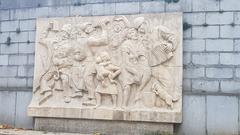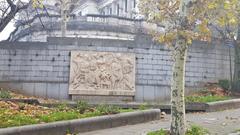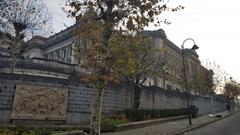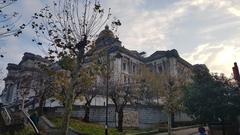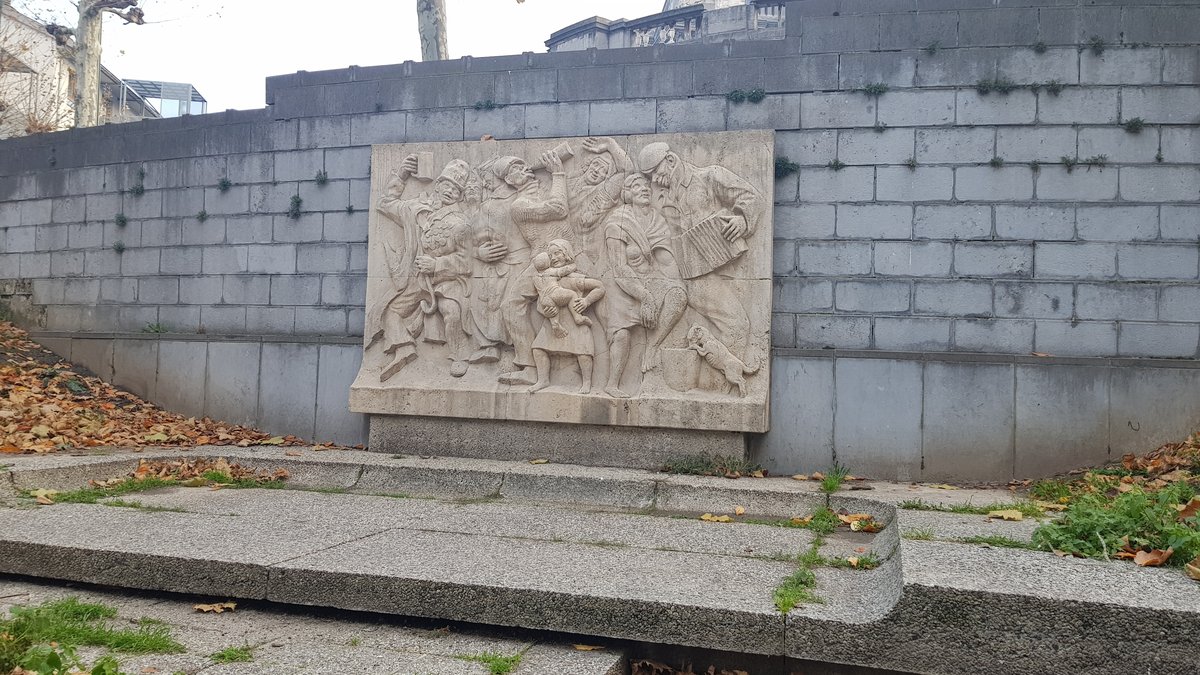
Monument to the Marolles: Visiting Hours, Tickets, and Comprehensive Guide to Brussels’ Historic District
Date: 14/06/2025
Introduction
The Monument to the Marolles, officially known as the “Monument aux Vivants” (Monument to the Living), stands as a vibrant tribute to the enduring spirit and cultural richness of Brussels’ Marolles district. Located in the heart of one of the city’s oldest neighborhoods, the monument encapsulates the Marolles’ working-class heritage, multicultural fabric, and distinctive Brusseleir dialect. Its presence commemorates not only the area’s past struggles—such as the displacement caused by the construction of the Palace of Justice—but also celebrates the community’s resilience and joie de vivre (Wikipedia; visit.brussels).
This guide explores the monument’s origins, artistic significance, practical visitor information, and the vibrant context of the Marolles neighborhood, providing everything you need for an enriching visit.
Table of Contents
- Historical Background of the Marolles
- Creation and Symbolism of the Monument
- Visiting Information: Hours, Tickets, and Accessibility
- Exploring the Marolles: Attractions & Experiences
- Travel Tips & Visitor Etiquette
- Frequently Asked Questions
- References and Further Reading
Historical Background of the Marolles
The Marolles—or Marollen in Dutch—is one of Brussels’ most storied districts, nestled between the Palace of Justice, the Church of Our Lady of the Chapel, and the Halle Gate (Wikipedia). Originating in medieval times, the area became a haven for artisans, laborers, and marginalized communities, developing a reputation for rebelliousness and solidarity. Its unique Brusseleir dialect and multicultural population reflect centuries of social evolution, shaped by waves of immigration and urban renewal (visit.brussels).
A defining event in Marolles’ history was the construction of the monumental Palace of Justice in the late 19th century. Designed by Joseph Poelaert, this project led to the expropriation and displacement of many residents, leaving a deep imprint on the district’s collective memory (visit.brussels). The trauma of forced transformation fostered a strong sense of local identity—marked by humor, resistance, and pride.
Creation and Symbolism of the Monument
Artistic Vision and Community Tribute
Inaugurated in 1933 and sculpted by Maurice Wolf, the Monument to the Marolles (“Monument aux Vivants”) is a rare public artwork that honors not the dead, but the living community of the Marolles (visit.brussels). Drawing inspiration from Pieter Bruegel the Elder’s “The Peasant Dance,” the monument’s bas-relief style depicts folkloric figures emblematic of Marolles’ indomitable spirit—characters such as Zot Lowietche, le Piot, sa Krotche, le Pottezoeiper, de Kikei, and the Zinneke.
The monument’s location—Rue du Faucon, near the Palace of Justice—underscores its symbolism, standing as a counterpoint to the grand edifice that once disrupted the district. It celebrates solidarity, humor, and the vibrancy of everyday life, reaffirming the Marolles’ place in Brussels’ evolving urban landscape (visit.brussels).
Design and Meaning
The bas-relief sculpture departs from traditional monuments by focusing on communal joy and cultural resilience rather than somber commemoration. Its lively figures, rendered with caricature and warmth, embody the humor and diversity of the Marolles, making the monument a unique testament to the neighborhood’s living heritage.
Visiting Information: Hours, Tickets, and Accessibility
Opening Hours & Tickets
- Hours: The monument is situated outdoors and is accessible 24/7, year-round.
- Entrance Fee: There is no entrance fee or ticket required—visiting is free (visit.brussels).
Getting There
- Metro: Louise/Louiza and Porte de Hal/Hallepoort (lines 2 and 6) are the nearest stations, with a short walk to the monument.
- Tram: Lines 92 and 93 stop at Poelaert, adjacent to the Palace of Justice. The panoramic elevator offers step-free access to the Marolles.
- Bus: Lines 27, 48, and 95 serve Place du Jeu de Balle and Rue Haute.
- On Foot: A 20-minute walk from the Grand Place provides a scenic approach through central Brussels.
For schedules and updates, visit the STIB/MIVB website.
Accessibility
The Marolles features cobblestone streets and some inclines, but the panoramic elevator at Place Poelaert ensures wheelchair and stroller accessibility between the upper city and Marolles. The monument is generally accessible, though assistance may be required for certain routes.
Facilities
- Restrooms: Available at Place du Jeu de Balle and in local cafés or bars (often for a small fee or purchase).
- Food & Drink: The area is famous for its eclectic cafés, traditional Belgian fare, and international eateries (happytowander.com).
- Shopping: Rue Haute and Rue Blaes offer antique shops, boutiques, and daily flea markets (laurewanders.com).
Exploring the Marolles: Attractions & Experiences
Nearby Landmarks
- Palace of Justice: A monumental courthouse offering panoramic city views and rich architectural history (visit.brussels).
- Place du Jeu de Balle: Home to Brussels’ oldest flea market, bustling daily from early morning until 2 PM.
- Notre Dame de la Chapelle: A grand Gothic church hosting concerts and exhibitions.
- Street Art: Murals like Jef Aérosol’s “Derniers poètes” on Rue du Faucon, and other contemporary works (brussels.be).
Events and Guided Tours
- Marollescence Festival: An annual illuminated art and photo exhibition that transforms the district into an open-air gallery (brussels.be).
- Guided Tours: Local operators and cultural centers offer walking tours exploring Marolles’ history, architecture, and folklore. Advance booking is recommended during peak seasons.
Cultural Life
The Marolles is renowned for its vibrant street life, artisan workshops, antique markets, and blend of languages and traditions. The area’s authenticity and humor are celebrated through ongoing community events and public art, making it a key destination for cultural immersion.
Travel Tips & Visitor Etiquette
- Best Time to Visit: Early morning for quiet exploration or during district events for lively atmosphere.
- Language: French and Dutch are official, but English is widely spoken.
- Currency: Euro (€). Carry cash for flea market purchases, though cards are generally accepted elsewhere.
- Dress: Comfortable shoes are recommended due to uneven surfaces.
- Safety: The district is safe, but as always, keep valuables secure in busy areas.
- Photography: Encouraged, but ask permission before photographing people, especially vendors.
- Support Local: Enjoy the cafés, markets, and boutiques, respecting the neighborhood’s local character.
Frequently Asked Questions
Q: Is there an entrance fee for the Monument to the Marolles?
A: No, it is free and open to the public at all times.
Q: What are the monument’s opening hours?
A: Accessible 24 hours a day, year-round.
Q: Are guided tours available?
A: Yes, through local operators and cultural centers. Self-guided tour options are also available.
Q: Is the area wheelchair accessible?
A: Yes, with the help of the panoramic elevator at Place Poelaert and generally accessible pathways.
Q: What else can I do in the Marolles?
A: Explore antique shops, flea markets, street art, and historical sites like the Palace of Justice and Notre Dame de la Chapelle.
Visuals and Media
Alt text: Monument To The Marolles, a symbolic outdoor sculpture in the Marolles district of Brussels.
Virtual tours, high-resolution images, and detailed maps are available on visit.brussels and the City of Brussels official website.
References and Further Reading
- Wikipedia: Marollen
- visit.brussels: The Marolles, Brussels’ authentic and popular neighbourhood
- visit.brussels: The little hidden secrets of the Marolles
- visit.brussels: Brussels Palace of Justice venue details
- brussels.be: Marollescence
- brussels.be: Architectural and artistic heritage
- happytowander.com: Brussels travel tips
- laurewanders.com: A local’s guide to Brussels
Conclusion
The Monument to the Marolles is more than a public sculpture—it is a living symbol of community resilience, creativity, and cultural diversity. Its free, 24/7 access and central location within a lively, storied district make it a must-visit for anyone seeking to understand Brussels’ true character. For the best experience, combine your visit with a stroll through local markets, a guided tour, or attendance at a cultural festival such as Marollescence. Make use of digital resources like the Audiala app for guided tours and up-to-date information, and immerse yourself in the heart of Brussels’ working-class heritage.

